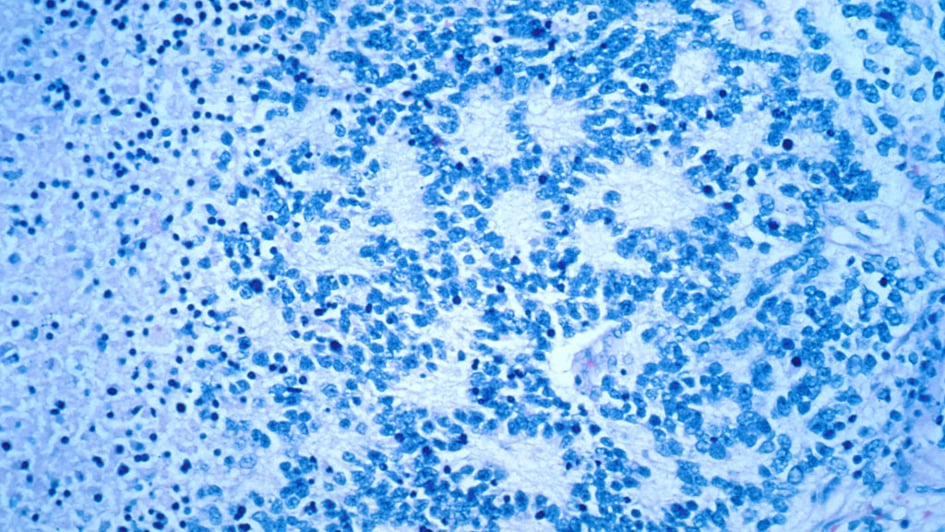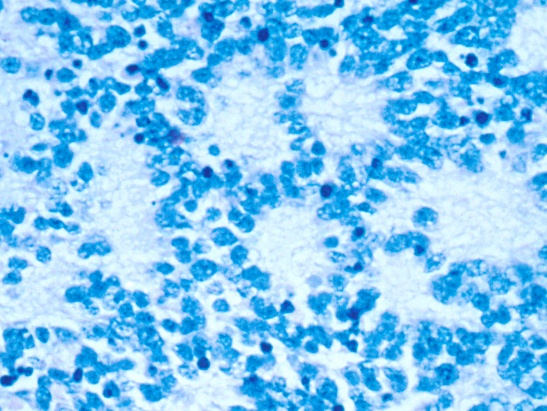
Image: Neuroblastoma. Image credit: Dr Maria Tsokos, National Cancer Institute.
New research has helped create a mouse model to help study a devastating childhood cancer and understand how it spreads.
Scientists have created a new mouse model which will help them to study neuroblastoma, a childhood cancer which often spreads around the body, and proves resistant to treatment.
To date, neuroblastoma research in mice has been limited by the cancer not being able to spread around the mouse’s body by itself, making the data gathered less applicable to real-world scenarios.
In new research by scientists at The Institute of Cancer Research, London, a mouse model which better reflects the real spread of neuroblastoma has been created and studied. The mice showed changes to their tumours which closely resembled what happens in children with the disease.
Current mouse models are also usually sensitive to treatment with chemotherapy drugs, while in patients, the disease is often resistant to these treatments.
The research was published in the journal Cancer Research, with funding from Neuroblastoma UK, Cancer Research UK and Children With Cancer UK.
September gives us a chance to highlight the incredible research that goes on at the ICR, but we continue to work tirelessly all year round to keep making the discoveries that we hope will one day defeat children’s cancer.
A more accurate representation
The cancer in the new model is also resistant to the front-line chemotherapy drug cyclophosphamide, making it an even more accurate representation of the types of aggressive neuroblastomas seen in children in the clinic.
To create the new model, scientists started out with commonly used research mice called Th-MYCN. These mice are genetically engineered to develop neuroblastoma which progresses rapidly.
Scientists treated the mice with multiple rounds of cyclophosphamide – a common chemotherapy drug used to treat neuroblastoma.
The mice were carefully monitored throughout this treatment and, bit-by-bit, they showed resistance to the drug.
The tumours then developed spontaneous metastases – the cancer spread of its own accord to new locations in the body, which mimicked the spread seen in children with neuroblastoma. In the case of these mice, the cancer spread to the bone marrow.
A fruitful avenue of exploration
Scientists noticed that genes associated with neuroblastoma were kicked into overdrive. They also found that a kind of expressway through which different molecules pass, called JAK-STAT3, was activated in the new mice. Its activation helped cancer cells survive, thrive and spread to new organs.
By treating the mice with a drug called CYT387, which shut down this expressway, scientists saw that the progression of the tumours was slowed down, and survival rates of the mice went up.
This could prove to be a fruitful avenue of exploration for future studies looking to discover new drugs to target neuroblastoma.
The new model will allow scientists to take a deeper look at how the cancer develops resistance to traditional chemotherapy and what weaknesses could be exploited for the development of new treatments.
Staying ahead of current treatment options
Professor Louis Chesler, Professor of Paediatric Solid Tumour Therapeutics at the ICR said:
“Neuroblastoma is an aggressive cancer and difficult to treat. The new model we have developed will prove to be a useful tool in looking at what drives neuroblastoma, its growth and development.
Developing a new model to help us look at what makes the cancer so resilient, even as it is put under pressure from treatments, will help us understand how neuroblastomas are able to stay ahead of current treatment options, and will form a basis for developing new and more innovative drugs in the future.”
